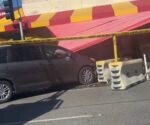‘I visited the bleak neighbourhood in one of Europe’s richest cities’ | World | News
Berlin is frequently ranked as one of Europe’s best cities. Whether visiting the German capital for a sightseeing holiday or moving there to live, the flood of people seeking a good time in the historic destination is continuous.
And, as popular travel guide TimeOut pointed out last year, it’s also a very welcoming place. “What makes Berlin great: Berlin is so much more than its clubs, its galleries and its reputation as the European capital of cool. The city might not be known for its friendliness, but Berliners are the heart and soul of the German capital,” the title wrote.
It’s a vibrant city with a vibrant economy. Many tech start-ups establish European HQs, and digital nomads pitch up to live there. This hub of activity has powered it to fifth place in the list of richest cities in Europe in terms of GDP.
However, as with all great cities, there is a dark side too.
The suburb of Marzahn didn’t exist until the 1970s when the East German Communist government erected sprawling prefabricated concrete housing blocks across an uninhabited flat expanse.
While the slightly depressing architecture remains today, the iron curtain that hid it from the Western world is long gone, and superficially, at least, it feels like most of the suburban neighbourhoods in the city.
There is little sinister about the empty shopping malls and large international supermarkets.
However, according to its residents behind the stereotypically bleak Soviet environment lurks a terrifying threat.
“This area has a lot of neo-Nazis,” warns one young local man who spoke on the condition of anonymity from a car park beside a discount store.
The student said he’d seen first-hand how this frightening group was making its presence known.
“They are drawing swastikas on the tables at the schools and colleges, chanting Nazi slogans,” he adds.
“In school, people are always singing ‘foreigners out’, this type of stuff.”
Despite having many migrants, Marzahn is a stronghold of the hard-right Alternative for Deutschland, and the young man I spoke to preferred the conservative Conservative Democratic Union to left-wing parties as they were more willing to tackle challenging issues.
“I like the conservatives because the left-wingers ignore the AfD voters, whereas they are trying to win them over with migration laws,” he added.
The young man is not alone in having concerns about the neo-Nazi elements in Marzahn.
An advice guide produced for football fans heading to Berlin for the Euro 2024 championship last year highlighted it as a district traveling supporters should be wary of.
“This neighbourhood is known to harbor neo-Nazi gangs. Far-right demonstrations are occasionally held, posing a risk of clashes with counter-protesters and police officers,” it read.
In October last year, Marzahn was the venue for a neo-Nazi demonstration and counter-protest that descended into violence.
The Berliner said a car was set ablaze. At the same time, “a journalist was attacked on the sidelines of the neo-Nazi protest, and several criminal investigations were initiated against participants for using symbols of unconstitutional organisations and violating the weapons law.”
It also reported that a group of neo-Nazis were beaten and robbed.
The presence of extremists in Marzahn is not a new phenomenon, however. A New York Times profile of a black ballet dancer from the neighbouhood said after the fall of communism it had been a hotbed for far-right racism.
“After the fall of the Berlin Wall in 1989, Marzahn was known for its neo-Nazis, and foreigners were warned not even to visit there,” the article claimed.









